11.10.2023
Chandrayaan-3’s measurements of sulfur open the doors for lunar science and exploration
Sulfur in soils near the moon's poles might help astronauts live off the land one day, making these measurements an example of science that enables exploration.
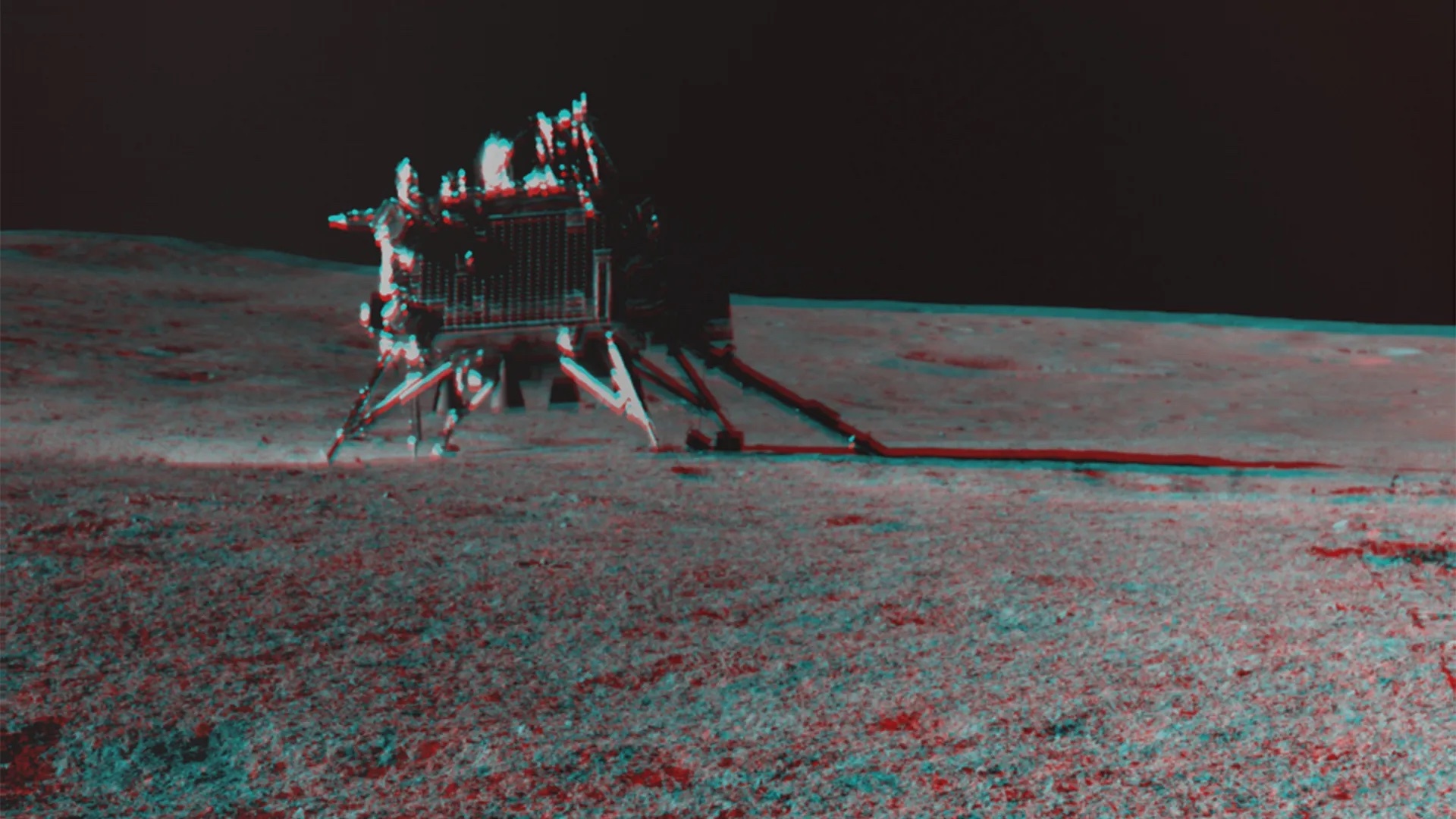
Chandrayaan-3’s Pragyan rover has traveled 328 feet. (Image credit: ISRO)
In an exciting milestone for lunar scientists around the globe, India's Chandrayaan-3 lander touched down 375 miles (600 km) from the south pole of the Moon on Aug. 23, 2023.
In just under 14 Earth days, Chandrayaan-3 provided scientists with valuable new data and further inspiration to explore the moon. And the Indian Space Research Organization has shared these initial results with the world.
While the data from Chandrayaan-3's rover, named Pragyan, or "wisdom" in Sanskrit, showed the lunar soil contains expected elements such as iron, titanium, aluminum and calcium, it also showed an unexpected surprise — sulfur.
Planetary scientists like me have known that sulfur exists in lunar rocks and soils, but only at a very low concentration. These new measurements imply there may be a higher sulfur concentration than anticipated.
Pragyan has two instruments that analyze the elemental composition of the soil — an alpha particle X-ray spectrometer and a laser-induced breakdown spectrometer, or LIBS for short. Both of these instruments measured sulfur in the soil near the landing site.
Sulfur in soils near the moon's poles might help astronauts live off the land one day, making these measurements an example of science that enables exploration.
Geology of the moon
There are two main rock types on the moon's surface — dark volcanic rock and brighter highland rock. The brightness difference between these two materials forms the familiar "man in the moon" face or "rabbit picking rice" image to the naked eye.
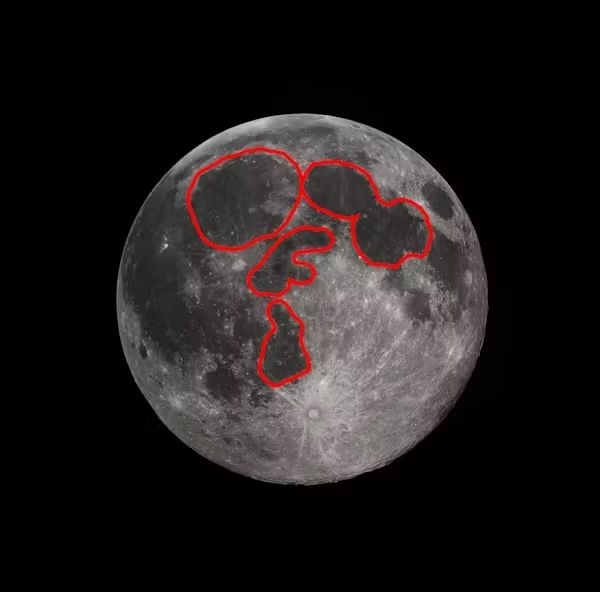
Scientists measuring lunar rock and soil compositions in labs on Earth have found that materials from the dark volcanic plains tend to have more sulfur than the brighter highlands material.
Sulfur mainly comes from volcanic activity. Rocks deep in the moon contain sulfur, and when these rocks melt, the sulfur becomes part of the magma. When the melted rock nears the surface, most of the sulfur in the magma becomes a gas that is released along with water vapor and carbon dioxide.
Some of the sulfur does stay in the magma and is retained within the rock after it cools. This process explains why sulfur is primarily associated with the moon's dark volcanic rocks.
Chandrayaan-3's measurements of sulfur in soils are the first to occur on the moon. The exact amount of sulfur cannot be determined until the data calibration is completed.
The uncalibrated data collected by the LIBS instrument on Pragyan suggests that the moon's highland soils near the poles might have a higher sulfur concentration than highland soils from the equator and possibly even higher than the dark volcanic soils.
These initial results give planetary scientists like me who study the moon new insights into how it works as a geologic system. But we'll still have to wait and see if the fully calibrated data from the Chandrayaan-3 team confirms an elevated sulfur concentration.
Atmospheric sulfur formation
The measurement of sulfur is interesting to scientists for at least two reasons. First, these findings indicate that the highland soils at the lunar poles could have fundamentally different compositions, compared with highland soils at the lunar equatorial regions. This compositional difference likely comes from the different environmental conditions between the two regions — the poles get less direct sunlight.
Second, these results suggest that there's somehow more sulfur in the polar regions. Sulfur concentrated here could have formed from the exceedingly thin lunar atmosphere.
The polar regions of the moon receive less direct sunlight and, as a result, experience extremely low temperatures compared with the rest of the moon. If the surface temperature falls, below -73 degrees C (-99 degrees F), then sulfur from the lunar atmosphere could collect on the surface in solid form — like frost on a window.
Sulfur at the poles could also have originated from ancient volcanic eruptions occurring on the lunar surface, or from meteorites containing sulfur that struck the surface and vaporized on impact.
Lunar sulfur as a resource
For long-lasting space missions, many agencies have thought about building some sort of base on the moon. Astronauts and robots could travel from the south pole base to collect, process, store and use naturally occurring materials like sulfur on the moon — a concept called in-situ resource utilization.
In-situ resource utilization means fewer trips back to Earth to get supplies and more time and energy spent exploring. Using sulfur as a resource, astronauts could build solar cells and batteries that use sulfur, mix up sulfur-based fertilizer and make sulfur-based concrete for construction.
Sulfur-based concrete actually has several benefits compared with the concrete normally used in building projects on Earth.
For one, sulfur-based concrete hardens and becomes strong within hours rather than weeks, and it's more resistant to wear. It also doesn't require water in the mixture, so astronauts could save their valuable water for drinking, crafting breathable oxygen and making rocket fuel.

While seven missions are currently operating on or around the moon, the lunar south pole region hasn't been studied from the surface before, so Pragyan's new measurements will help planetary scientists understand the geologic history of the moon. It'll also allow lunar scientists like me to ask new questions about how the moon formedand evolved.
Quelle: SC
----
Update: 28.10.2023
.
Vikram lander raised lot of dust during lunar landing, created ejecta halo
Scientists at ISRO estimated that the landing event had ejected 2.09 tonnes of lunar regolith over 108.4 square metre area. During the touchdown phase of the Vikram lander, the ejecta displacement could be seen from the lander's Landing Image Camera (LIC)
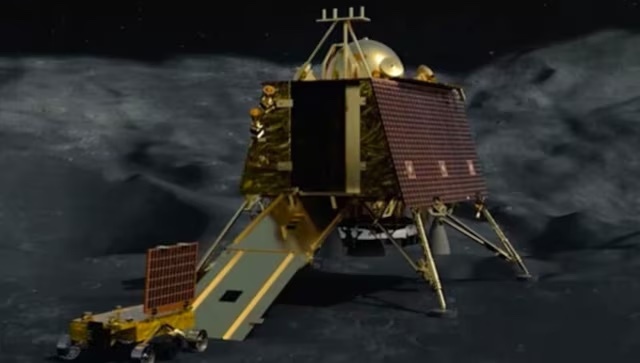
The scientists examined pre-and post-landing images of the landing site acquired from the OHRC onboard Chandrayaan-2 orbiter. File Photo.
When the Vikram lander of the Chandrayaan-3 mission made a soft landing on the moon it raised a lot of dust that led to creation of a bright patch, called as the ejecta halo, around the spacecraft, the ISRO said on Friday.
According to a research paper published in the Journal of the Indian Society of Remote Sensing, scientists at ISRO used the Orbiter High Resolution Camera (OHRC) onboard the Chandrayaan-2 orbiter to study the lunar surface hours before and after the soft-landing of Vikram lander on the moon on August 23.
“During the action of descent stage thrusters and the consequent landing, a significant amount of lunar surficial epiregolith material got ejected, resulting in a reflectance anomaly or ‘ejecta halo’,” scientists at the National Remote Sensing Centre (NRSC) said in the paper.
They estimated that the landing event had ejected 2.09 tonnes of lunar regolith over 108.4 square metre area.
The scientists examined pre-and post-landing images of the landing site acquired from the OHRC onboard Chandrayaan-2 orbiter.
“The Vikram lander’s position is seen as a centrally located brightened spot on the image due to reflection from the lander’s on-body solar panels. The shadow of the lander is seen as an elongated oval-shaped dark patch towards the left of the lander,” they said in the paper.
“Associated with these two features is the veneer of the ejecta halo, which appears as an irregular bright patch surrounding the lander, as seen clearly in the post-landing OHRC image,” they reported.
According to the scientists, studying soil erosion due to rocket exhaust on the Moon is important as the ‘off-surface ejecta’ material can potentially threaten lander/rover onboard instruments.
During the touchdown phase of the Vikram lander, the ejecta displacement could be seen from the lander’s Landing Image Camera (LIC).
The ejecta halo phenomenon has been documented in the case of almost all lunar landings, more so from the Apollo landing missions which had considerably heavy landers.
The first documented evidence of the ejecta displacement was during the Apollo 11 mission when astronaut Buzz Aldrin commented “picking up some dust” when the Eagle lander touched down on the lunar surface on July 20, 1969.
During the Apollo-11 mission de-brief, Aldrin said he noticed that the lander was disturbing the dust on the surface and it was something less than 100 feet from the lunar surface.
Quelle: Firstpost
----
Update: 2.11.2023
.
India's Chandrayaan-3 moon lander kicked up a 'halo' of dust visible from space
Chandrayaan-2 witnessed Chandrayaan-3 do what it could not.

The first image of the moon's surface taken by India's Chandrayaan-3 mission after its historic touchdown on Aug. 23, 2023. (Image credit: ISRO via Twitter)
On Aug. 23, 2023, India did what only three other countries before it had done: Make a successful soft landing on the moon.
Millions of eyes watched the Indian Space Research Organisation (ISRO)'s Chandrayaan-3 as its lander touched down on the lunar surface and began its science operations in the days afterward. In fact, some of those eyes were aboard the mission's predecessor, Chandrayaan-2, whose cameras captured the landing site of Chandrayaan-3's Vikram lander from its perch in lunar orbit.
It seems that those photos from Chandrayaan-2's orbiter captured an "ejecta halo," a huge ring-shaped plume of moon dust that the latter-day lander's thrusters left in the lunar soil as they glided it to a touchdown.
Chandrayaan-2's photos show the volume of that initial success: As Chandryaan-3's lander touched down, its engines scattered the lunar regolith, or moon dust, below. In a new study, scientists estimate the landing displaced around 2.06 metric tons (4,500 pounds) of lunar regolith, sending it across an area of 1,167 square feet (108.4 square meters).
Scientists noticed the halo based on the differences in reflectivity in the newly-disturbed top layers of moon dust, or epiregolith. "The loss of cohesion of the epiregolith and consequent exposure of subsurface regolith may have resulted in increased photometric scattering and thus, the reflectance anomaly around the lander," the authors of the new study on the ejecta halo write.
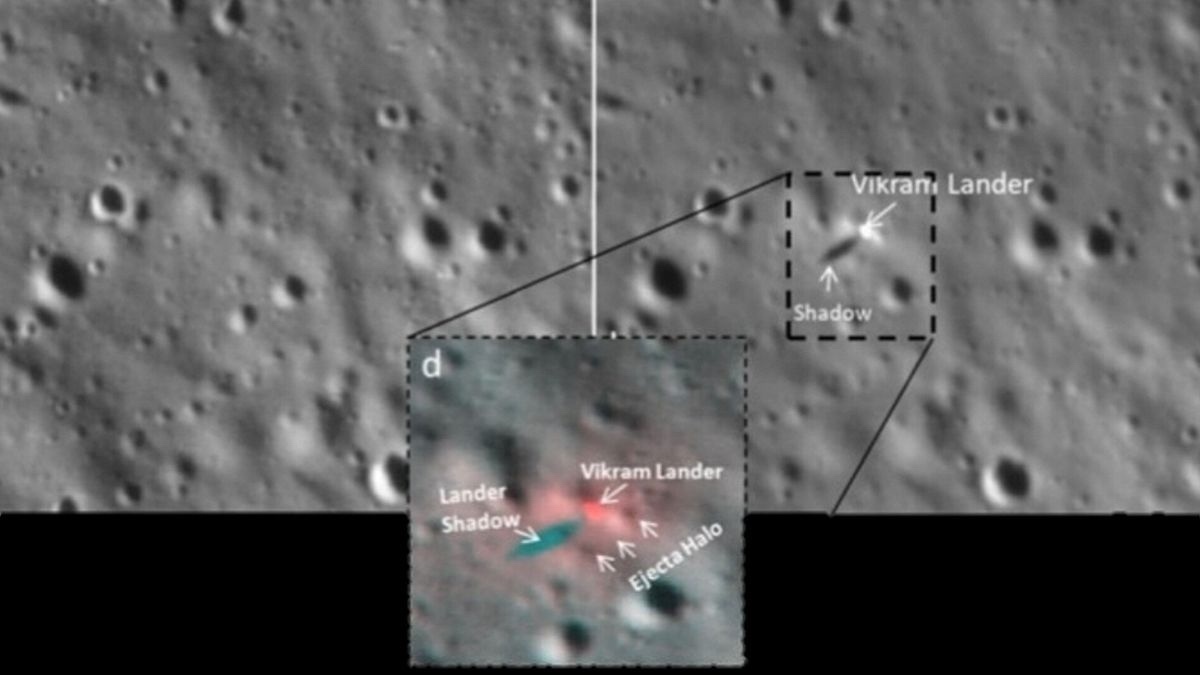
Chandrayaan-3's landing site before landing (left) and after (right), with a composite showing the ejecta halo surrounding the Vikram lander. (Image credit: ISRO via Twitter
In a way, Chandrayaan-2 witnessed Chandrayaan-3 do what it could not.
Chandrayaan-2 launched from southern India's Satish Dhawan Space Center on July 22, 2019 and entered lunar orbit on Aug. 19. The mission set out to put a lander and rover near the lunar south polar region, something that had never been done before.
Unfortunately, when the lander set off on Sept. 6 (Sept. 7 IST) 2019, ISRO ground control lost contact when it was just 1.3 miles (2.1 kilometers) above the lunar surface, and never re-established it.
Nevertheless, Chandrayaan-2’s orbiter continued to function normally, mappingthe lunar terrain and taking high-resolution photographs of the lunar surface.
Nearly four years later, Chandrayaan-3 lifted off from the same launch site with the same general mission: Place a lander and rover in the south polar region. On Aug. 23, 2023, ISRO conducted the first successful landing near the lunar south pole.
Only three nations had soft-landed on the moon previously: The United States, the Soviet Union, and China. But more soft landings should be coming shortly; NASA has funded several robotic missions in support of its moon-faring Artemis program, some of which may touch down as soon as 2024. Japanese company ispace has already attempted to land a robot on the moon, and Russia assures the world it will soon be back after the failed landing attempt of its Luna-25 mission, which crashed in August 2023.
A study of Chandrayaan-3's ejecta halo was published in the Journal of the Indian Society of Remote Sensing on Oct. 26.
Quelle: SC
----
Update: 6.12.2023
.
India returns Chandrayaan-3 propulsion module to Earth orbit
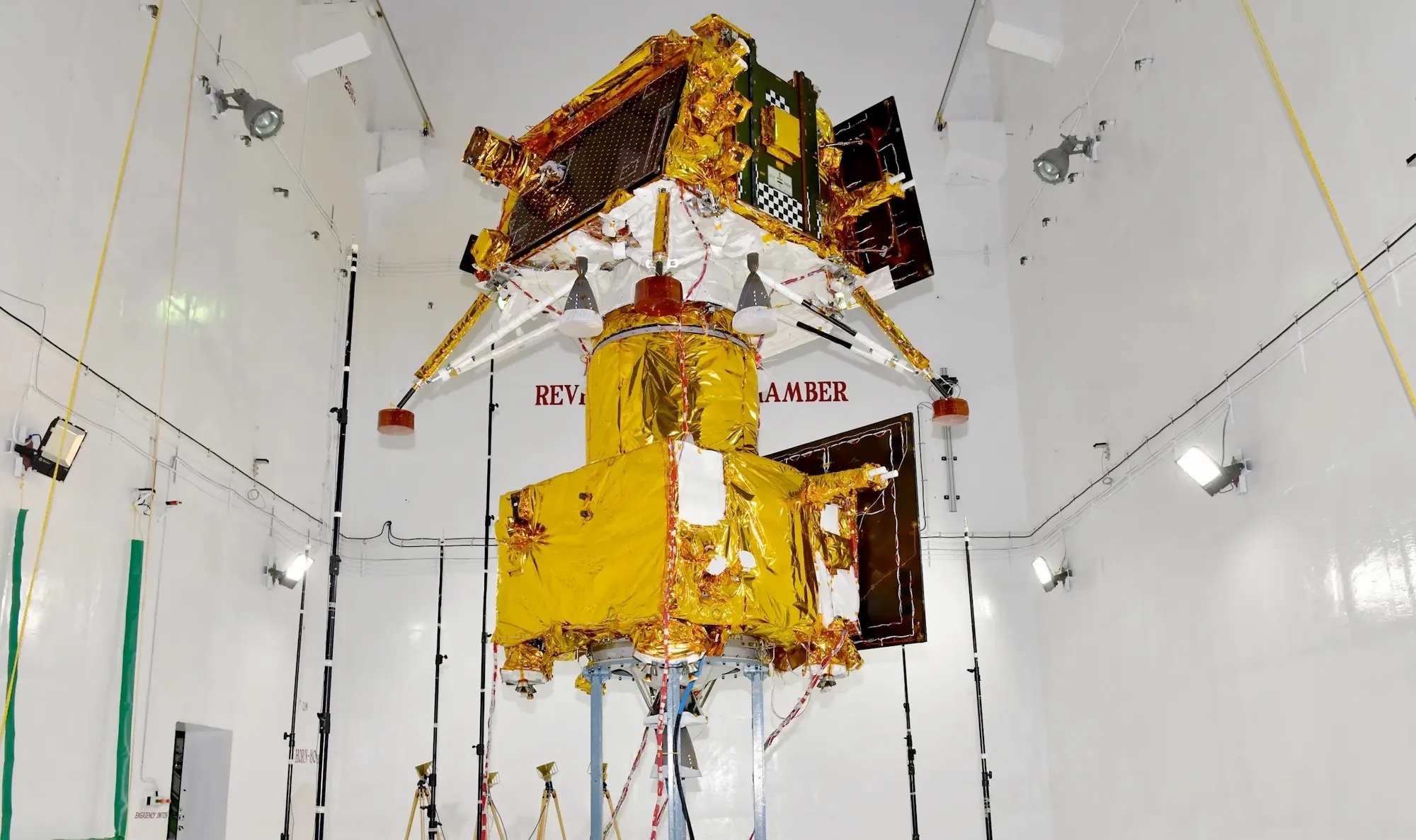
The Chandrayaan-3 propulsion module, seen here below the lander in pre-launch preparations, has returned from lunar orbit to a high Earth orbit. Credit: ISRO
WASHINGTON — The spacecraft that transported the Chandrayaan-3 lander to the moon has returned to Earth orbit, a demonstration of technologies to support a future Indian lunar sample return mission.
The Indian space agency ISRO announced Dec. 4 that the propulsion module for the Chandrayaan-3 mission is now in a high orbit around the Earth after a series of maneuvers since October that returned the spacecraft from a low lunar orbit. ISRO had not previously disclosed any efforts to return the propulsion module to Earth orbit.
The main purpose of the 2,145-kilogram propulsion module was to transport the Chandrayaan-3 lander from an initial elliptical Earth orbit to low lunar orbit. The module, a modified version of ISRO’s I-3K satellite bus, performed several maneuvers starting a day after its July 14 launch to raise the apogee of the orbit, followed by a translunar injection burn and lunar orbit insertion burn. The module than moved into a nearly circular orbit about 150 kilometers above the moon before the lander separated Aug. 17.
The lander successfully touched down on the moon Aug. 23. The propulsion module remained in orbit, operating a single instrument called Spectro-polarimetry of Habitable Planet Earth, or SHAPE, to observe the Earth. ISRO provided little information about the propulsion module after the lander separated.
In a statement, ISRO said that it decided to attempt to bring the propulsion module back to Earth orbit after determining that the precision of the launch and earlier maneuvers left more than 100 kilograms of propellant on the spacecraft. The first maneuver in that plan took place Oct. 9, raising the apolune, or high point in its orbit around the moon, from 150 to 5,112 kilometers.
The module performed a transearth injection maneuver Oct. 13, placing it on a trajectory where it performed four close approaches to the moon before leaving its sphere of influence on Nov. 10. The spacecraft entered a high orbit around the Earth, making its first perigee Nov. 22 at an altitude of 154,000 kilometers.
ISRO said the maneuver allowed SHAPE to continue observations closer to Earth. It added, though, that the maneuvers were designed “to derive additional information for future lunar missions and demonstrate the mission operation strategies for a sample return mission.”
ISRO has not formally announced plans for a lunar sample return mission. Its next mission to the moon is the Lunar Polar Exploration Mission, or LUPEX, a joint effort with the Japanese space agency JAXA. That mission, sometimes called Chandrayaan-4, would feature a Japanese rover on an Indian lander to explore the south polar region of the moon. It is expected to launch no earlier than 2026.
However, ISRO officials have discussed the potential of a near-term sample return mission. “The government of India has given us a very tight timetable for exploration in space. We need to have a sample return from the moon within about four years,” said Shri M. Sankaran, director of ISRO’s U R Rao Satellite Center, during a panel discussion at the AIAA’s ASCEND conference Oct. 24 in Las Vegas.
He appeared to be referring to a meeting of ISRO leadership chaired by Indian Prime Minister Narendra Modi Oct. 17. A release by the prime minister’s office mentioned goals that included an Indian space station by 2035 and Indian crewed lunar landing by 2040, but did not discuss lunar sample return.
In a later presentation at the conference, he said that ISRO had developed a concept for a sample return mission, but did not go into details about it. “Maybe this sample return and LUPEX mission with JAXA may happen more or less concurrently,” he said.
The return of the propulsion module to Earth orbit was not the first demonstration of technologies needed for lunar sample return on Chandrayaan-3. In its final days of operations on the lunar surface in September, the lander reignited its engines, rising about 40 centimeters off the surface before touching down 30 to 40 centimeters away from its original landing location. “This ‘kick-start’ enthuses future sample return and human missions!” ISRO posted on social media.
Quelle: SN
----
Update: 15.01.2024
.
Meticulous planning the key to Chandrayaan-3 success, says ISRO scientist
A press note from the University said the scientist also highlighted the meticulous work carried out by the ISRO teams of scientists in guiding the safe moon landing of the Chandraayaan-3
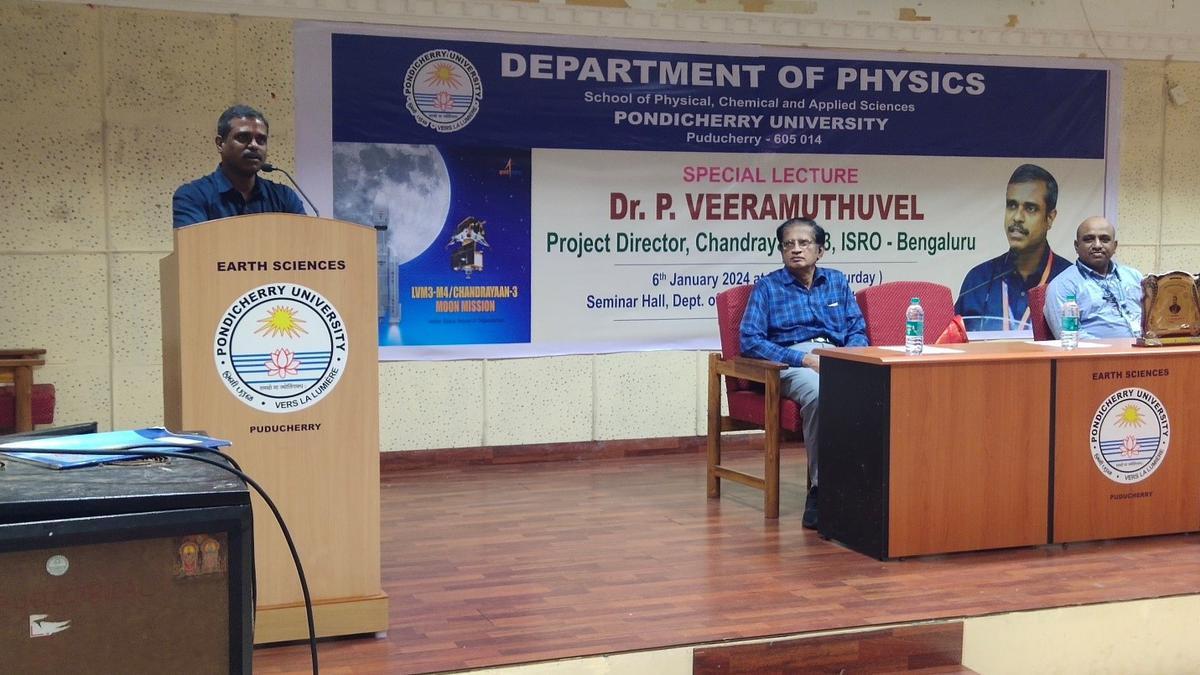
P.Veeramuthuvel, Project Director of Chandrayaan-3 at a recent lecture hosted by the Department of Physics, School of Physical, Chemical and Applied Sciences of Pondicherry University. | Photo Credit: Special Arrangement
P. Veeramuthuvel, Project Director of Chandrayaan-3 from ISRO, Bengaluru shared several aspects of the meticulous planning that went into the successful moon mission at a recent programme hosted at the Pondicherry University.
ISRO captures high-resolution images of Chandrayaan-3's Vikram lander, Pragyan rover resting on Moon

The high-resolution image captured on March 15 this year showed significantly greater detail than last year's image shared by ISRO. Photograph:(Others)
The Indian Space Research Organisation (ISRO) has captured high-resolution images of Chandrayaan-3's lander Vikram, and the Pragyan rover resting on the Moon. Blog post on Moon and Beyond (a blog run by independent researcher Chandra) on Wednesday (May 1) said that the new images were captured on March 15.
"Following a successful touchdown at ShivShakti Statio, the Vikram Lander from Chandrayaan-3 deployed its rover, Pragyan, to navigate the cratered lunar surface," the blog post said.
"Equipped with integrated cameras, Pragyan transmitted video footage of its surroundings and commenced its research tasks, designated for a two-week exploration mission," it added.
On August 25 last year, ISRO reported that Pragyan had covered a distance of eight meters shortly after deployment. By the conclusion of its mission, the rover had successfully traversed approximately 101 metres.
Despite the success of the Chandrayaan-3 mission, Vikram and Pragyan did not withstand the harsh conditions of the Moon's southern environment and were presumed non-operational. Though the Indian space agency released images of Vikram lander on August 23, 2023, the exact location of Pragyan's final resting place remained unclear.
"Today, for the first time, we can clearly see the little Pragyan positioned right beside Vikram," the post added.
The high-resolution image captured on March 15 this year showed significantly greater detail than last year's image shared by ISRO.
The latest image was obtained from a reduced altitude of approximately 65 kilometres, allowing for a resolution of about 17 cm, compared to the initial post-landing image captured at the regular altitude of 100 kilometres with a resolution of 26 cm.
"The difference in resolution is markedly apparent when observing these two images side by side; details such as the crater contours are exceptionally visible," the post added.
Quelle: WION
